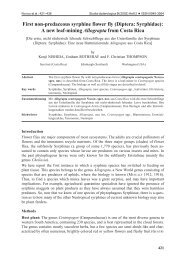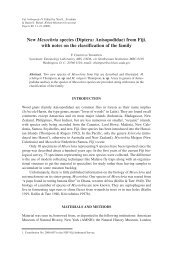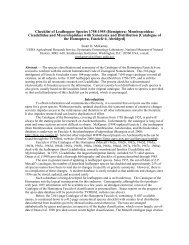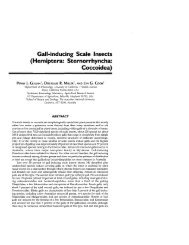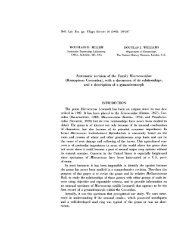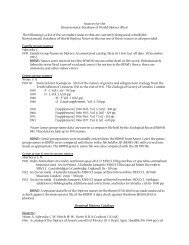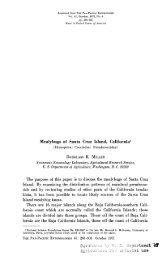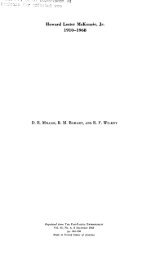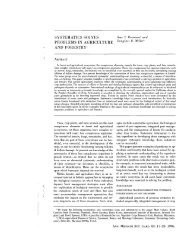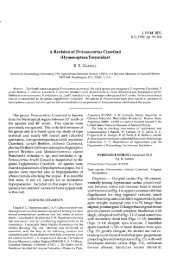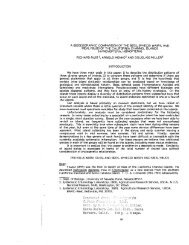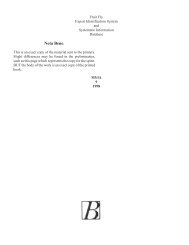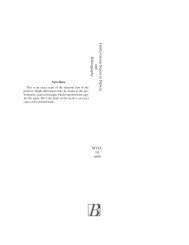A NEW SPECIES OF PUTa AND A PRELIMINARY ANALYSIS OF ...
A NEW SPECIES OF PUTa AND A PRELIMINARY ANALYSIS OF ...
A NEW SPECIES OF PUTa AND A PRELIMINARY ANALYSIS OF ...
Create successful ePaper yourself
Turn your PDF publications into a flip-book with our unique Google optimized e-Paper software.
A <strong>NEW</strong> <strong>SPECIES</strong> <strong>OF</strong> <strong>PUTa</strong> <strong>AND</strong> A <strong>PRELIMINARY</strong><br />
<strong>ANALYSIS</strong> <strong>OF</strong> THE PHYLOGENETIC POSITION <strong>OF</strong><br />
THE <strong>PUTa</strong> GROUP WITHIN THE COCCOIDEA<br />
(HOMOPTERA: PSEUDOCOCCIDAE)<br />
Douglass R Miller and Gary L Miller<br />
Systematic Entomology LaboratOlY<br />
Plant Sciences Institute, Agricultural Research Service<br />
United States Department of Agriculture<br />
Beltsville, MD 20705<br />
ABSTRACT<br />
Three instars of the female and five instars of the male Puto kosztarabi are<br />
described and illustrated. This represents the first described species from eastern<br />
North America. A checklist of the known species of Puto, keys to the adult male<br />
Puto, North American female Puto, and instars to P. kosztarabi are included.<br />
Acladistic analysis utilizing 23 taxa and 38 characters supports the monophyly<br />
of the Puto group.<br />
NARRATIVE<br />
The genus Puto Signoret includes 57 species and is known from the<br />
Holarctic and Neotropics. In the United States, 22 species have been<br />
described to date, all of which occur in the western states. The "Puto<br />
group" (McKenzie, 1967) is closely related to the pseudococcids, but there<br />
has been some disagreement in deciding whether it should be treated<br />
taxonomically as a pseudococcid (Williams & de Willink, 1992) or as a<br />
separate family (Beardsley, 1969). There also has been some speculation<br />
about the relationship of Puto to other annectant genera such as<br />
Pityococcus McKenzie, Steingelia Nassonov, and Phenacoleachia<br />
Cockerell (Miller, 1983). These taxa each have males with more than<br />
)effersoniana, Number 4, pp. 1-35<br />
Virginia Museum of Natural History, 1993
2 MIllER & MILLER: puro KOSZTARABI<br />
three pairs of eyes and distinct tail-fonning pore clusters, and two of the<br />
three have abdominal spiracles.<br />
The objectives of this paper are: 1) to describe the first species of Pulo<br />
known from the eastern United States and place it in a key to species; 2)<br />
to present a preliminary key to the adult males of available Pulo species;<br />
3) to provide a world checklist of Pulo species; and 4) to report on the<br />
relationships of Pulo with selected margarodid, pseudococcid, and<br />
phenacoleachid genera.<br />
MATERIALS <strong>AND</strong> METHODS<br />
Morphological tenninology follows McKenzie (1967) for the adult<br />
female, Afifi (1968) for the adult male, and Miller (1991) for first and<br />
second instars. Measurements and numbers are from 10 specimens,<br />
when available, and are given as a mean with ranges in parentheses.<br />
Specimens of the genus Pulo exhibit an array of sclerotized areas that<br />
contain concentrations of conical setae and trilocular pores. In most<br />
mealybugs, these areas would be called cerarii, but most authors have<br />
treated only those areas that are located near the body margin as true<br />
cerarii, and have tenned similar areas within the confines of the body<br />
perimeter as setal areas with basal sclerotization. We will continue this<br />
usage, but also note that many specimens of Pulo koszlarabi have<br />
cerarian-like structures scattered over most of the dorsum. Some<br />
specimens of P. koszlarabi were reared in the greenhouse on Spartina<br />
alterniRora Loisel. because this grass was readily available and its natural<br />
host of Danlhonia spicala (L) Beauvois ex R. & S. was not easily<br />
accessible. Spartina alterniRora should not be considered a natural host<br />
of this species.<br />
Cladistic analyses were perfonned using Hennig86 (Farris, 1988). The<br />
data matrix consisted of 23 taxa and 38 characters. Outgroup comparison<br />
was used to detennine polarities of characters. The Margarodidae were<br />
considered the most primitive Coccoidea by Beardsley (1968), and<br />
Matsucoccus biselosus Morrison was chosen as a rootoutgroup species.<br />
The implicit enumeration (ie) command was applied to detennine the<br />
most parsimonious trees. A strict consensus tree was generated by using<br />
the "Nelson" command.<br />
Characters were selected from adult males, adult females, and first<br />
instars. Thirty-eight characters were used in the analysis. Characters 4,<br />
9, 13, and 21 (treated as non-additive) and 1, 11, 12, 14, 19, 27, 28, 29,
JEFFERSONIANA<br />
and 32 (treated as additive) have three or more states; all others are<br />
binary. Plesiomorphic characters were coded as O. Apomorphic characters<br />
were either coded as 1 to 3 (if additive) or a and b (if non-additive).<br />
Character states were determined through examination of specimens<br />
deposited in the National Museum of Natural History Collection and<br />
through previously published descriptions. These species were selected<br />
since either slide-mounted material or published descriptions were<br />
available for adult males, adult females, and first instars of each species.<br />
All available adult males of Puto were examined in the collections of<br />
the California Department of Food and Agriculture (Sacramento), The<br />
Natural History Museum (London, UK.), National Museum of Natural<br />
History (Beltsville, Maryland), and University of California, Davis.<br />
Depositories of specimens are: National Museum of Natural History,<br />
Washington, D.C. (USNM)j The Natural History Museum, London,<br />
UK. (NHM)j University of California, Davis «UCD)j and Virginia<br />
Polytechnic Institute and State University, Blacksburg (VPI).<br />
SYSTEMATIC TREATMENT<br />
Checklist of Known Species of Puto<br />
References to the listed species correspond to citations in this paper or<br />
the following bibliographies of the Coccoidea: Morrison & Renk (1957),<br />
Morrison & Morrison (1965), Russell et al. (1974), and Kosztarab &<br />
Kosztarab (1988). Known distribution for each species follows each<br />
citation.<br />
1. Puto acirculus McKenzie, 1967: California<br />
2. Puto alMcans McKenzie, 1967: California<br />
3. Puto ambiguus (Fullaway, 1910a): California<br />
4. Puto antennatus (Signoret, 1875b): Europe<br />
5. Puto antioquensis (Murillo, 1931): Colombia<br />
6. Puto arctostaphyli Ferris, 1950b: California<br />
7. Puto asteri (Takahashi, 1932): Japan<br />
8. Puto atriplicis McKenzie, 1961: Western US.<br />
9. Puto barberi Cockerell, 1895q: Caribbean and Venezuela<br />
10. Puto borealis Borchsenius, 1948b: Palearctic<br />
11. Pulo bryanlhi Ferris, 1950b: California<br />
12. Pulo caballeroi (Gomez-Menor, 1948): Spain<br />
3
4 MIllER & MIllER: PlJfO KOSZTARABI<br />
13. Puio calcitecius (Cockerell, 1901j): New Mexico<br />
14. Puio californicus McKenzie, 1967: California<br />
15. Puio caucasicus Hadzibejli, 1956: Republic of Georgia<br />
16. Puio clematidis Matesova, 1957: Kazakhstan<br />
17. Puio cupressi (Coleman, 1901): Western U.S. and<br />
Canada<br />
18. Puio decorosus McKenzie, 1967: California<br />
19. Puio echinatus McKenzie, 1961: California<br />
20. Puio erigeroneus (Kanda, 1959a): Japan<br />
21. Puio euphorbiaefolius Bodenheimer, 1943: Iraq<br />
22. Puio ferrisi (Kiritshenko, 1936a): Russia<br />
23. Puio graminis Danzig, 1972b: Sakhalin Island<br />
24. Puio kosziarabi n. sp.<br />
25. Puio janetscheki Balachowsky, 1953m: France, Czech<br />
Republic, and Slovakia<br />
26. Puio jarvdensis Tang, 1992: China (possibly not a Puio)<br />
27. Puio kiritshenkoi (Borchsenius, 1949): Russia<br />
28. Puio kondarensis (Borchsenius, 1948c): Tadzhikistan<br />
29. Puio konoi Takahashi, 1941c: Sakhalin Island<br />
30. Puio lamoffei MatHe-Ferrero, 1985: Venezuela<br />
31. Puio lasiorum (Cockerell, 1901j): Western U.S.<br />
32. Puio laticribellum McKenzie, 1961: California<br />
33. Puio marsicanus Marotta & Tranfaglia, 1993: Italy<br />
34. Puio megriensis (Borchsenius, 1948b): Armenia<br />
35. Puio mexicanus Cockerell, 18930: Texas and Mexico<br />
36. Puio mimicus McKenzie, 1967: California (possibly not a<br />
Puio)<br />
37. Puio nulliporus McKenzie, 1960: California (possibly not<br />
a Puio)<br />
38. Puio orienialis Danzig, 1978c: Sakhalin Island<br />
39. Puio ornatus (Green, 1922): India and China (possibly<br />
not a Puio)<br />
40. Puio orihezioides (Cockerell, 1903a): Mexico<br />
41. Puio pacificus McKenzie, 1967: California<br />
42. Puio palinuri Marotta & Tranfaglia, 1993: Italy<br />
43. Puio paramoensis MatHe-Ferrero, 1985: Venezuela<br />
44. Puio pilosella (Sulc, 1898): Europe<br />
45. Puio pini Danzig, 1972b: Far East<br />
46. Puio porierii (Bodenheimer, 1943): Israel
JEFFERSONIANA<br />
47. Puto pricei McKenzie, 1960: California<br />
48. Puto profusus McKenzie, 1960: California<br />
49. Puto sandini Washburn, 1965: Utah<br />
50. Puto simmondsiae McKenzie, 1961: California and<br />
Mexico<br />
51. Puto subericola Nayssiere, 1927): Morocco<br />
52. Puto superbus (Leonardi, 1907b): Europe<br />
53. Puto tauricus (Borchsenius, 1948b): Crimea, China,<br />
Greece, Italy<br />
54. Puto tubulifer Danzig, 1978c: Far East<br />
55. Puto ulter Ferris, 1950b: Central and South America<br />
56. Puto usingeri McKenzie, 1962: Peru<br />
57. Puto vaccinii Danzig, 1978c: Far East<br />
58. Puto yuccae (Coquillett, 1890): U.S. and Mexico<br />
Treatment of Adult Male<br />
The following preliminary key to known males of the world Puto is the<br />
first to be presented for this genus. Few male specimens were available<br />
for many of the species; consequendy, the limits of intraspecific variation<br />
for most species are poorly known, and many of the characters used in<br />
the key may be subject to future revision. The species of Puto examined<br />
for the following key are listed below followed by locality, collection date,<br />
number of specimens studied, and depository. The following specimens<br />
were examined: Puto albicans: Bass Lake, California, VI·20-78, 1 male<br />
(CDA)j P. ambiguus: Alameda, California, Y-?-06, 1 male (USNM); P.<br />
antennatus: Berchtesgaden, Germany, VII-30-51, 2 males (USNM)j P.<br />
antioquensis: Fredonia, Colombia, XII-7-29, 2 males (USNM)j P.<br />
arctostaphyli: New Indria, California, VI-?-1884, 3 males (USNM)j Grass<br />
Valley, California, VI-20-n, 3 males (CDA); P. atriplicis: Murphy,<br />
Idaho, VI-5-63, 1 male (USNM); Chalfont, California, VIII-7-73, 1 male<br />
(USNM); Bishop, California, X-4-73, 2 males (CDA); Mountain Home,<br />
Idaho, IX-I0-75, 2 males (USNM)j P. calcitectus: Beulah, New Mexico,<br />
VII-27-OO,1 male (USNM)j P. cupressi: Eugene, Oregon, 1976, 3 males<br />
(USNM); P. decorosus: Camp Angelus, California, 1 male (USNM); P.<br />
echinatus: Carpenteria, California, IV-I-82, 1 male (CDA); P. kosztarabi:<br />
see description of adult male; P. mexicanus: Mexico, VIII-9-39, 1<br />
male (USNM)j Kenedy, Texas, X-24-40, 1 male (USNM)j Mexico, V-22<br />
41, 1 male (USNM); Durango, Mexico, III·U-n, 2 male (USNM)j<br />
5
6 MIllER &.. MIllER: puro KOSZTARABI<br />
Mexico, 1-27-74, 1 male (USNM); Mexico, XII-B-80, 1 male (USNM);<br />
Mexico, IY-25-B7, 1 male (USNM); P. sandini: Thousand Mountain<br />
Lake, Utah, YUH-53, 1 male (USNM); Loa, Utah, VIII-24-55, 2 males<br />
(USNM); P. simmondsiae: Black Hill, California, IY-22-78, 1 male<br />
(USNM); P. superbus: Furth, N. Bavaria, VI-2-50, 1 male (USNM);<br />
Athens, Greece, IY-15-68, 1 male (CDA); P. ulter: Guatemala, Y-8-46,<br />
1 male (USNM); Mexico, 111-21-52, (1 male) (USNM).<br />
Key to Known Adult Males of Puto<br />
1 Male wingless or brachypterous . . . . . . . . . . . . . . . . . . . . . 2<br />
Male fully winged . . . . . . . . . . . . . . . . . . . . . . . . . . . . .. 3<br />
2(1) 4 eyes and 1 ocellus on each side of head; wings absent;<br />
aedeagus blunt apically superbus (Leonardi)<br />
6 or 7 eyes and 1 ocellus on each side of head; wings represented<br />
by small lobes; aedeagus apically acute or bifurcate ..<br />
· ambiguus (Fullaway) and echinatus McKenzie<br />
3(1) Aedeagus blunt apically; ventral surface of ocular sc1erites<br />
with sc1erotization restricted to area near eye 4<br />
Aedeagus acute or bifurcate apically; ventral surface of ocular<br />
sc1erites with sc1erotization continuous from preocular ridge<br />
to postocular ridge . . . . . . . . . . . . . . . . . . . . . . . . . . . . 5<br />
4(3) 7 eyes and 1 ocellus on each side of head; dorsal surface of<br />
penial sheath without sc1erotization around base of setae;<br />
antennal segment 3 more than 350 Jlm long .<br />
· cupressi (Coleman)<br />
6 eyes and 1 ocellus on each side of head; dorsal surface of<br />
penial sheath with sc1erotization around base of setae;<br />
antennal segment 3 less than 350 Jlm long .<br />
· antennata (Signoret) and sandini Washburn<br />
5(3) Aedeagus with 2 sc1erotized teeth on ventral surface proximal<br />
of apex; without teeth on apex of aedeagus (Figs.<br />
2g & 2h) 6<br />
Aedeagus without sc1erotized teeth on ventral surface proximal<br />
of apex; with several teeth on apex of aedeagus . . . . . . 7
JEFFERSONIANA 7<br />
6(5) Each tail-fonning pore cluster with less than 250 pores<br />
excluding tubular pores (Fig. 2d) 0 0 , • 0 0 0 .kosztarabi, no spo<br />
Each tail·fonning pore cluster with more than 250 pores<br />
excluding tubular pores. 0 0 0 • 0 0 •• 0 • ealciteetus (Cockerell)<br />
7(5) Each tail·fonning pore cluster with 200 or more pores<br />
excluding tubular pores . 0 • 0 0 • 0 0 0 0 ••• 0 0 0 0 •• 0 0 0 0 0 • 8<br />
Each tail·fonning pore cluster with less than 200 pores<br />
excluding tubular pores 0 0 0 •• 0 0 0 0 • • • 0 0 0 0 • 0 0 0 • 0 0 0 0 9<br />
8(7) Each tail·fonning pore cluster with more than 400 pores<br />
excluding tubular pores; longest seta on antennal<br />
segment 9 greater than 450 /lm 0 ••• 0 antioquensis (Murillo)<br />
Each tail·fonning pore cluster with less than 400 pores<br />
excluding tubular pores; longest seta on antennal<br />
segment 9 less than 450 /lm 0 0 0 0 0 • 0 0 0 albieans McKenzie,<br />
aretostaphyli Ferris, mexieanus (Cockerell) (in part),<br />
ulter Ferris, yueeae (Coquillett)<br />
9(7) Genal setae with associated multilocular pores; body setae<br />
fleshy, with slighdy rounded apices; third antennal seg·<br />
ment predominandy with setae less than half length of<br />
segment . 0 0 • 0 0 0 0 0 •• 0 • 0 • 0 0 0 0 0 •• 0 atriplicis McKenzie<br />
Genal setae without associated multilocular pores; body setae<br />
filamentous, with acute apices; third antennal segment<br />
predominandy with setae longer than half length of segment<br />
(excluding setae associated with base of long setae) 0 0 10<br />
10(9) Sclerotized portion of each side of penial sheath with more<br />
than 75 setae; more than 25 setae on tegula . 0<br />
0 0 • • • • 0 • 0 0<br />
o. 0 • 0 0 0 0 • 0 • 0 ••• 0 0 0 • 0 0 • 0 •• 0 0 0 deeorosus McKenzie<br />
Sclerotized portion of each side of penial sheath with less<br />
than 60 setae; with less than 20 setae on tegula 0<br />
•• 0 •• 0 0 0 0<br />
o. 0 0 0 0 0 0 0 0 0 • 0 0 0 •••• 0 0 mexieanus (Cockerell) (in part)<br />
Key to Adult Females of Puto in North America<br />
(modification of McKenzie [1967])<br />
1 Ventral multilocular disk pores present on last 2 abdomi·
8 MIllER & MIllER: PillO KOSZTARABI<br />
nal segments . . . . . . . . . . . . . . . . . . . . . . . . . . . . . . . . 3<br />
Ventral multilocular disk pores absent on last 2 abdominal<br />
segments . . . . . . . . . . . . . . . . . . . . . . . . . . . . . . . . 2<br />
2(1) Oral-rim type tubular ducts present, sparingly distributed<br />
on dorsum; usually not more than 18 enlarged conical<br />
setae in anal cerarius . . . . . . . . . . . . . nulliporus McKenzie<br />
Tubular duct of any kind absent on dorsum; often as<br />
many as 28-30 enlarged conical setae in anal lobe<br />
cerarius 0 •••••• 0 • • • • • mimicus McKenzie<br />
3(1) Dorsal setae with basal sclerotization, coalesced into cerariilike<br />
structures . . . . . . . . . . . 0 • • • • • • 0 • • • • • • • • • • • • A<br />
Dorsal setae without basal sclerotization or with sclerotization<br />
restricted to area around setal socket, not coalesced<br />
into cerarii-like structures 0 ••••••••••••••••••••<br />
o 0 •••••• 0 • (continue at couplet 4 in McKenzie's 1967 key)<br />
A(3) Cerarii without oral collar tubular ducts (Fig. Id) B<br />
Cerarii with oral collar tubular ducts .... .lasiorum (Cockerell)<br />
B(A) Head without large-sized tubular ducts near body margin<br />
adjacent to anterior cerarii . . . . . . . . . . . . . . . . . . . . . . . C<br />
Head with large·sized tubular duets near body margin adjacent<br />
to anterior 1 or 2 cerarii (Fig. 1e) ....kosztarabi, n. spo<br />
C(B) Circulus present. calcitectus (Cockerell)<br />
Circulus absent 0 • • • • • • • • acirculus McKenzie<br />
TREATMENT <strong>OF</strong> <strong>SPECIES</strong><br />
Key to Instars (Except Third-instar Female) of Puto kosztarabi<br />
2<br />
1 Without wings or wing pads . . . . . . . . .. 0<br />
With wings or wing pads . . . . . . . . . . . . . . . . . . . . . . . 0 • 4<br />
• • • • • • • • • • • •<br />
2(1) Vulva present; antenna 9-segmented; frontal cerarius with<br />
18 or more conical setae (Fig. 1) .. fourth·instar female (adult)<br />
Vulva absent; antenna 7-segmented; frontal cerarius with
JEFFERSONIANA 9<br />
8 or fewer conical setae . . . . . . . . . . . . . . . . . . . . . . . . . 3<br />
3(2) Oral-collar tubular ducts abundant, scattered over dorsal<br />
surface, along ventral lateral margin, and anterior of<br />
mouthparts (Fig. 6) . . . . . . . . . . . . . . . . second-instar male<br />
Oral-collar tubular ducts few, restricted to area anterior of<br />
cerarii on dorsal and ventral surfaces, and anterior of<br />
mouthparts (Fig. 5) . . . . . . . . . . . . . . . second·instar female<br />
4(1) Wings well developed; legs and antennal setae with associated<br />
short basal setae; genital capsule with sclerotized<br />
aedeagus (Fig. 2) fifth-instar male (adult)<br />
Wings in form of pads; legs and antennal setae without<br />
associated short basal setae; genital capsule without sclertized<br />
aedeagus 5<br />
5(4) Wing pads greater than 700 J.lm long; lateral sclerite of abdominal<br />
segment VII with fimbriate projection (Fig. 3) ..<br />
. . . • . • . . . . . . . . . . . . . . . . . . . . . . . . fourth·instar male<br />
Wing pads less than 125 J.lm long; lateral sclerite of abdominal<br />
segment VII without fimbriate projection (Fig. 4)<br />
. . . . . . . . • . . . . . . . . . . • . . . . . . . . . . . third-instar male<br />
Puto kosztarabi, new species<br />
(Figures 1-8)<br />
Suggested Common Name: Buffalo Mountain Mealybug<br />
Diagnosis: Adult female with numerous dorsal conical setae on sclerotized<br />
bases, large-sized tubular ducts restricted to anterior head region, and<br />
circulus present or absent.<br />
Type Data: Holofype, adult female, U.S.A. We have chosen and<br />
marked as holotype an adult female labeled "Puto kosztarabi/ D. Miller<br />
& G. Miller/ VIRGINW Floyd Co./ Buffalo Mtn./ 4 August 1992/ M.<br />
Kosztarab coll./ ex: Danthonia spicata" (USNM). There is also a<br />
paratype on the slide; the specimen located horizontally near the edge of<br />
the coverslip is the holotype. A label has been placed on the slide giving<br />
the exact location of the holotype. Parafypes, 22 adult females, 9 adult<br />
males, 4 pupal males, 2 prepupal males, 3 second-instar females, 3
10 MIllER & MIllER: puro KOSZTARABI<br />
second-instar males, 19 first instars, U.S.A.: In addition to the paratype<br />
associated on the slide with the holotype, there are 61 paratypes on 37<br />
slides (NHM, UCD, USNM, VPI). Complete collection information is<br />
presented in the corresponding "Specimens examined" section for the<br />
adult and immature stages.<br />
Etymology: The species is named in honor of Michael Kosztarab, who<br />
has diligently added to the systematic knowledge of scale insects through<br />
his personal research and the research of his students. This species was<br />
collected by Michael in his quest to better understand the diversity of<br />
insect life in Virginia.<br />
Habitat: Puto kosztarabi is associated with the grass Danthonia<br />
spicata on Buffalo Mountain (elev. 3,972 ft.), Hoyd County, Virginia.<br />
Both mealybug and grass are found near the summit's higher elevations<br />
in unique prairie-like glades that contain magnesium-rich soils. The<br />
Buffalo Mountain site is the only known site of this mealybug. Nine<br />
other similar ecological habitats in Virginia and North Carolina were<br />
examined in 1992 and 1993, but P. kosztarabi was not collected in any<br />
of these other sites (Michael Kosztarab, pers. comm.).<br />
Adult female (fourth instar)<br />
Figure 1<br />
" Slide-mounted characters: Holotype oval, length 2.4 mm, width 1.0<br />
mm; paratypes 3.6 (2.5-4.6) mm, 1.9 (1.4-2.6) mm.<br />
Dorsum: With 21 pairs of cerarii, paratypes 20 (19-21); anal-lobe<br />
cerarius (Fig. 1d) with 29 conical setae, paratypes 29 (26-33) and 46<br />
trilocular pores, paratypes 54 (39-61), without associated discoidal pores<br />
or tubular ducts; frontal cerarius with 19 conical setae, paratypes 22<br />
(18-28) and 13 trilocular pores, paratypes 12 (9-19), without associated<br />
discoidal pores or tubular ducts; all cerarii with basal sclerotization.<br />
Multilocular disc pores absent; trilocular pores (Fig. 1c) scattered;<br />
discoidal pores (Fig. 1b) of 1 size, most abundant along body margin and<br />
on thorax and head. Oral-collar tubular ducts of large size (Fig. 1e)<br />
located near anterior cerarii on dorsal and ventral surface, with 3 ducts<br />
on each side of head, paratypes with 3 (1-7), oral collars absent elsewhere.<br />
Body setae conical (Fig. 1a), usually with basal sclerotization and<br />
associated trilocular pores, often coalesced with other dorsal setae, longest<br />
seta on abdomen 26 j..Im long, paratypes 33 (29-36) j..Im, about same size<br />
as cerariian setae; with 53 setae on segtl)ent V, excluding those in cerarii,<br />
paratypes with 53 (45·59).
JEFFERSONIANA<br />
Fig. 1. Adult female of P. kosztarabi. Buffalo MOl., Floyd Co., Virginia, VUH<br />
1993, on Danthonia spicata. a. conical body seta; b. discoidal pore; c. trilocular<br />
pore; d. cerarian setae; e. frontal oral-eollar tubular duct; f. large-sized oral-eollar<br />
tubular duct; g. circulus variation; h. 5-locular pore; i. small-sized oral-
12 MIllER & MIllER: puro KOSZTARABI<br />
Longest anal-ring seta 247 J.lm long, paratypes 243 (233-317) J.lrn,<br />
apices capitate; 1.7 times as long as greatest diameter of ring, paratypes<br />
1.5 (1.1-1.8) times.<br />
Venter: With multilocular pores in posterior areas of segments III-VIII,<br />
paratypes III or IV-VIII, in anterior areas on segments I-VIII, with pores<br />
abundant on thorax and head; loculi variable, some specimens with<br />
predominandy 5 (Fig. 1h) and 7 (Fig. 1k) locular pores, others with<br />
predominandy 9 (Fig. 1j) and 10 locular pores. Trilocular pores of 2<br />
sizes, smaller size in irregular rows across medial and mediolateral areas<br />
of each abdominal segment, larger size present near body margin;<br />
triloculars absent on medial and mediolateral areas of thorax and head.<br />
Discoidal pores scattered over surface. Orakollar tubular duets smaller<br />
than on dorsum, of 2 sizes, smaller size (Fig. 1i) arranged in transverse<br />
rows on abdominal segments III-VIII, paratypes II or III-VIII, larger size<br />
(Fig. 1f) restricted to raised area on head anterior of mouthparts, with 48<br />
ducts on holotype, paratypes 56 (43-63). Ventral setae arranged in rows<br />
on abdomen, with 28 setae on segment V, paratypes 33 (28-38), longest<br />
seta on segment V 99 J.lm long, paratypes 103 (96-113) J.lm; longest<br />
anal-lobe seta 96 J.lm long, paratypes 120 (90-146) J.lm; longest seta on<br />
trochanter of hind leg 151 J.lm long, paratypes 196 (163-227) J.lm.<br />
Circulus absent or reduced (Fig. 1g), of 20 paratypes examined, 7 lack<br />
circulus, 8 possess 2 oval areas representing circulus remnants, and 5<br />
have well-developed circulus; when present located on posterior margin<br />
of segment III. Labium 189 J.lm long, paratypes 215 (192-236) J.lm.<br />
Posterior spiracle greatest length 108 J.lm, paratypes 136 (96-160) J.lm.<br />
Antennae 9-segmented, antenna 984 J.lm long, paratypes 1190 (1080<br />
1296) J.lm, apical segment 143 J.lm long, paratypes 174 (160-183) J.lm,<br />
segment II 105 J.lm long, paratypes 118 (108-128) J.lm, segment III 134<br />
J.lm long, paratypes 159 (140-180) J.lm; length of segment IX divided by<br />
length of segment II 1.4, paratypes 1.5 (1.3-1.6), length of segment IX<br />
divided by length of segment III 1.1, paratypes 1.1 (1.0-1.2). Legs with 8<br />
translucent pores on hind femur, paratypes 5 (2-8), with 39 translucent<br />
pores on hind tibia, paratypes 36 (23-35). Femur 447 J.lm long, paratypes<br />
540 (504-588) J.lm; tibia 612 J.lm long, paratypes 733 (696-758) J.lm;<br />
tarsus 252 J.lm long, paratypes 286 (252-300) J.lm. Tibia/tarsus 2.4,<br />
paratypes 2.5 (2.4-2.8). Hind tarsus with 23 setae, paratypes 23 (19·26).<br />
Hind trochanter with 4 sensory pores on each surface.<br />
Unusual variation. One specimen has many more than 6 anal-ring<br />
setae.
14 MIlLER & MIlLER: PUTO KOSZTARABI<br />
Specimens examined. VIRGINIA, Floyd Co.: S. slope Buffalo Mountain,<br />
VIII·1·76, on Danthonia spicata, R. L Hoffman (8 paratypes on 4<br />
sl.) USNM; Buffalo Mountain, VIII-4-92, on Danthonia spicata, M.<br />
Kosztarab (1 holotype, 14 paratypes on 11 sl.) NHM, ueD, USNM,<br />
VPI.<br />
Adult male (fifth instar)<br />
Figure 2<br />
Slide-mounted characters: Body length 3.1 (2.8·3.5) mm; greatest width<br />
at thorax 0.8 (0.7-0.9) mm.<br />
Dorsum: With 1 pair of tail-forming pore clusters on segment VIII,<br />
each with 2 central setae with slightly swollen apices, longest seta 215<br />
(186·247) Jlm long, with 143 (116-176) multilocular pores (Fig. 2d), 40<br />
(32-62) tubular pores (Fig. 2c) surrounding central setal bases, 15 (7·22)<br />
discoidal pores, and 28 (22·32) associated setae. Posterior ostioles present.<br />
Multilocular pores normally with 4 loculi, rarely 3 or 5, arranged in rows<br />
near setal bases on all abdominal segments (abdominal segment V with<br />
28 [23-38] pores), abundant in membranous area anterior of metapost·<br />
notum and posterior of pronotal ridge, absent on head. Discoidal pores<br />
(Fig. 2b) most abundant near body margin, occasionally in medial and<br />
mediolateral areas near bases of setae. Body setae slightly shorter than<br />
those on venter (longest seta on segment V 106 [87·128] j.lm), in lateral<br />
cluster and in transverse row on each abdominal segment, present on<br />
metathorax, scutellum, posterior portion of prescutum, with 1 or 2 on<br />
each side of scutum, 'on tegula with 7 (4·9) on each side, in row posterior<br />
of pronotal ridge, on pronotal sclerite, in genal cluster with 8 (5·10) in<br />
each cluster, on ocular sclerites abundant on dorsomedial sclerite with 28<br />
(24-33) setae on each side of mid-cranial ridge excluding setae on occipital<br />
sclerite. Abdominal tergites with 2 areas of sclerotization on anterior<br />
margin of segments VI-II, abdominal tergite VIII with 2 roughly<br />
triangular plates that normally are not connected. Metapostnotal ridge<br />
usually represented by single sclerotized area. Scutellum with distinct<br />
scutellar suture and scutellar ridge. Prescutum with prescutal ridge absent<br />
or represented by weak suture connected to scutellum thus dividing<br />
scutum in 2 pieces. Triangular clear area present anterior of scutellum.<br />
Pronotal ridge present, with conspicuous pronotal sclerites. Postoccipital<br />
and postocular nearly contiguous, weakly divided by swelling in lateral<br />
apex of postoceipital ridge; dorsal arm of midcranial ridge touching<br />
postoceipital ridge posteriorly, with broad lateral arms of midcranial ridge<br />
at apex of head. Preocular ridge beginning near lateral margin of sclero
18 MIllER & MIllER: PUTO KOSZTARABI<br />
1/2 to 3/4 size of procoxa. Preoral ridge connected to postocular ridge to<br />
form boundary of ocular sclerite. Preocular ridge touching ventral arm of<br />
midcranial ridge. Ocular sclerite sclerotized in all areas except near preoral<br />
ridge and near posterior connection of postocular ridge. Ventral arm of<br />
midcranial ridge connected posteriorly to preoral ridge and anteriorly to<br />
dorsal and lateral arms of midcranial ridge. Head set on unusually long<br />
neck; ventral surface with 4 or 5 pairs of eyes.<br />
Setae on trochanter, femur, and tibia with 1 (1-3) smaller setae closely<br />
associated with setal base (Fig. 2f). Trochanter with 4 (2-5) sensoria on<br />
each surface, tibia of hind leg 898 (780-984) J.lm long; tarsus 328<br />
(288-366) J.lm long; tibia/tarsus 2.7 (2.5-2.8); claw 87 (80-102) J.lm long,<br />
with pair of basal denticles, large denticle about 3/4 of distance from claw<br />
base to tip, and small denticle near tip; claw digitules apically acute,<br />
extending to large denticle on plantar surface; tarsal digitules apically acute<br />
not reaching tip of claw (Fig. 2e). Antennae 10-segmented, 3.4 (2.9-3.6)<br />
mm long; apical segment 266 (228-300) J.lm long; segment III 436<br />
(384-480) J.lm long; apical segment! segment III 0.6 (0.6-0.7); most<br />
abundant type of seta unusually long and with associated smaller setae<br />
near setal base, this type present on all but segment 1; antennal bristles<br />
on apical 3 segments; hair-like setae on all segments, with 2 small setae<br />
on intersegmental membrane at apex ofsegments 3 and 4, base of most<br />
segments with more heavily sclerotized ring giving appearance of separate<br />
small segment.<br />
Specimens examined. VIRGINIA, Floyd Co.: Buffalo Mountain, VIII·<br />
4-92, on Danthonia spicata, M. Kosztarab (9 paratypes on 9 s1.) NHM,<br />
UeD, USNM, VPI.<br />
Fourth-instar male (pupa)<br />
Figure 3<br />
Slide-mounted characters: Body length, 2.58 (2.37-2.87) mm, width<br />
0.71 (0.68-0.74) mm. Body elongate.<br />
Dorsum: Predominantly membranous with abdominal sclerites and<br />
antennal, ocular, and wing bud sclerotization. Multilocular disk pores<br />
with 5-9 loculi located on lateral, submedial, and medial areas of thorax<br />
and abdomen; absent from head. Longest body setae 42 (35-54) J.lm on<br />
segment IX and genital capsule. Postocular ridge represented by weak<br />
sclerotized band, ocular sclerites present. Front wing buds 754 (719-815)<br />
J.lm long, with partial sclerotization; hamulohalterae present. Posterior<br />
ostioles present. Lateral abdominal sclerites on segments on I-VIII, seg
JEFFERSONIANA<br />
Fig. 5. Second-instar female of P. kosztarabi. Beltsville, Prince Georges Co.,<br />
Maryland, 26-VI-1979, on Sparlina alterniflora in greenhouse.<br />
19
20 MILLER & MILLER: PUTO KOSZTARABI<br />
ment VIII extending medially. Sclerotization present on medial areas of<br />
segment IX. Sclerites of segments VI·VII and occasionally IV·V with<br />
fimbriate projections. Genital capsule conical, sclerotized throughout<br />
except near dorsal anal opening. Genital slit represented by small<br />
invagination. Genital capsule 246 (237·259) 11m long, 232 (209·259) 11m;<br />
width/length ratio of capsule 0.94 (0.86·1.06).<br />
Venter: Membranous with fewer body setae and multilocular pores.<br />
Mouth and ventral cavity weakly discernible. Ocular region and postoc·<br />
ular ridge inconspicuous. Antenna 1.25 (1.11·1.48) mm lortg. Prosternal<br />
ridge, mesosternal apophysis (£Urea), and metasternal apophysis evident.<br />
Legs sclerotized; hind tibia 407 (375·64) 11m long, hind tarsus 293 (277·<br />
319) 11m; hind tibia/tarsus ratio 1.4 (1.3·1.5). Abdominal sternites absent.<br />
Specimens examined. VIRGINIA, Floyd Co.: Buffalo Mountain, VIII·<br />
4·92, on Danthonia spicata, M. Kosztarab (4 paratypes on 2 sl.)<br />
USNM.<br />
Third·instar female<br />
(not observed)<br />
Third·instar male (prepupa)<br />
Figure 4<br />
Slide·mounted characters: Same as pupa except as follows: Body length,<br />
2.37 (2.26·2.48) mm, width 0.96 (0.94-0.99) mm.<br />
Dorsum: Predominandy membranous with antennal and wing bud<br />
scIerotization. Multilocular disk pores with 5 loculi located on medial area<br />
head. Longest body setae 48 (47-49) 11m on segment IX and genital<br />
capsule. Front wing buds 110000·120) 11m long, with partial sclerotiza·<br />
tion; hamulohalterae inconspicuous. Orakollar tubular ducts short,<br />
sclerotized, scattered over surface. Lateral abdominal scIerites absent.<br />
Genital capsule 148 043·153) 11m long, 220 (217·222) 11m wide;<br />
width/length ratio of capsule 1.49 (1.43·1.55).<br />
Venter: Antenna 643 (593·692) 11m long. Multilocular disk pores with<br />
7·9 loculi. Hind tibia 371 (n=l) 11m long, hind tarsus 128 (n=l) 11m;<br />
hind tibia/tarsus ratio 2.9.<br />
Specimens examined. MARYl<strong>AND</strong>, Prince Georges Co.: Beltsville,<br />
VIII·17·1979, on Spartina in greenhouse, W. Sweeney 0 paratype)<br />
USNM; VIRGINIA, Floyd Co.: S. slope Buffalo Mountain, VIII·l·1976,<br />
on Danthonia spicata, R. L Hoffman (l paratype) USNM.
JEFFERSONIANA<br />
Fig. 6. Second·instar male of P. kosz/arabi. Beltsville, Prince Georges Co.,<br />
Maryland, 17·VlII·1979, on Spar/ina alterniflora.<br />
21
22 MIllER & MIllER: puro KOSZTARABI<br />
Second-instar female<br />
Figure 5<br />
Slide-mounted characters: Same as adult female except as follows: Body<br />
length 1.4 (1.3-1.5) mm; width 0.7 (0.6-0.8) mm.<br />
Dorsum: With 18 (18 or 19) pairs of cerarii; anal-lobe cerarius with 8<br />
(7·9) setae and 16 (15-17) trilocular pores; frontal cerarius with 7 (6 or 7)<br />
conical setae and 3 (2 or 3) trilocular pores. Trilocular and discoidal<br />
pores less abundant than on adult female, of same distribution. Oral-
JEFFERSONIANA<br />
Fig. 7. First-instar of P. kosztarabi. Buffalo Mm., Floyd Co., Virginia, VIII-4<br />
1993, on Danthonia spicata.<br />
23
24 MILLER & MILLER: PUfO·KOSITARABI<br />
Second-instar male<br />
Figure 6<br />
Slide-mounted characters: Same as adult female except as follows: Body<br />
length 2.4 (2.1-2.6) mm; width 1.2 (1.1-1.4) mm.<br />
Dorsum: With 18 (18 or 19) pairs of cerarii; anal-lobe cerarius with 9<br />
(7-10) setae and 19 (16-22) trilocular pores; frontal cerarius with 7 (6-8)<br />
conical setae and 4 (3-5) trilocular pores. Trilocular and discoidal pores<br />
less abundant than on adult female, of same distribution. Ora1-collar<br />
tubular ducts of 2 sizes, small size scattered over surface, large size located<br />
near anterior cerarii on dorsal and ventral surfaces, with 2 (1-3) ducts on<br />
each side of head, 1 specimen with a single large duet between cerarius<br />
1 and 2. Longest body seta on abdomen 33 (31-35) Jlm long; with 15<br />
(13·18) setae on segment V, excluding those in cerarii.<br />
Anal.ring seta 177 (172-183) Jlm long; 1.4 (1.3·1.5) times as long as<br />
greatest diameter of ring.<br />
Venter with multilocular pores in anterior bands on all abdominal<br />
segments, sometimes with short posterior band on most anterior<br />
abdominal segments, with pores abundant on thorax and head. Trilocular<br />
pores of 2 sizes, restricted to sublateral areas of body. Discoidal pores less<br />
abundant than on adult female, scattered over surface. Ora1-collar tubular<br />
duets in rows across segments, also present on raised area on head<br />
anterior of mouthparts, with 17 (15·20) duets. Ventral setae arranged in<br />
rows on abdomen, with 11 setae on segment V, longest seta on segment<br />
V 74 (70-81) Jlm long; longest anal-lobe seta 94 (81-102) Jlm long;<br />
longest seta on trochanter of hind leg 125 (119·131) Jlm long.<br />
Circulus absent. Labium 150 (137-166) Jlm long. Posterior spiracle<br />
greatest length 92 (79-102) Jlm. Antennae 7-segmented, length of right<br />
antenna 696 (648·720) Jlm, apical segment 133 (128·143) Jlm, segment<br />
II 79 (73-84) Jlm, segment III 149 (137-163) Jlm; length of segment VII<br />
divided by length of segment II 1.7 (1.6-1.8), length of segment VII<br />
divided by length of segment III 0.9. Legs without translucent pores.<br />
Length of femur 295 (279-317) Jlm; tibia 383 (364-419) Jlm; tarsus 190<br />
(186-198) Jlm. Tibia/tarsus 2.0 (2.0 or 2.1). Hind tarsus with 16 (16 or<br />
17) setae.<br />
Specimens examined. MARYI<strong>AND</strong>, Prince Georges Co.: Beltsville,<br />
VII-24-79 and VIII-17·79, on Spartina alterniHora in greenhouse, W.<br />
Sweeney (3 paratypes on 3 s1.) USNM. The infestation originated from<br />
Buffalo Mountain, Virginia.
JEFFERSONIANA<br />
First instar (sexes undetermined)<br />
Figure 7<br />
Slide-mounted characters: Same as adult female except as follows: Body<br />
length 1.2 (0.9-1.4) mm, width 0.7 (0.5-0.9) mm.<br />
Dorsum: With 18 pairs of cerarii; anal-lobe cerarius with 2 conical<br />
setae; cerarii 2 through 8 each with 2 conical setae; cerarius 9 with 3; 10<br />
with 1; 11 with 3; 12 with 1; 13 with 3; 14 with 1; 15 with 2; 16 with<br />
6 (6 or 7); 17 with 1; 18 with 2. Trilocular pores associated with cerarii<br />
as follows: cerarius 1 with 3 pores; cerarius 2 with 3 pores; 3 with 3 (2<br />
or 3); 4 and 5 with 2; 6 and 7 with 2 (2 or 3); 8 with 2; 9 with 2 (2 or<br />
3); 10 with 2 (l or 2); 11 with 3 (2 or 3); 12 with 2 (1 or 2); 13 with 3<br />
(2 or 3); 14 with 1 (0 or 1); 15 with 3; 16 with 4 (3-6); 17 with 1 (l or<br />
2); and 18 with 1 (l or 2). Trilocular pores arranged in 11 (9-13)<br />
longitudinal lines on abdomen. Body setae conical, with basal sclerotization,<br />
often with associated trilocular pores and coalesced with other dorsal<br />
setae, longest seta on abdomen 35 (32-38) IJm long; with 7 (6·8) setae on<br />
segment V, excluding those in cerarii.<br />
Anal-ring seta 47 (41-50) IJm long; 1.6 (1.5-1.7) times as long as<br />
greatest diameter of ring.<br />
Venter: With multilocular pores arranged in 2 longitudinal lines on<br />
mediolateral area of abdomen, slightly more numerous on thorax and<br />
head, mostly with 9 or 10 loculi. Trilocular pores of 2 sizes, smaller size<br />
in irregular rows across medial and mediolateral areas of each abdominal<br />
segment, larger size present near body margin, absent elsewhere.<br />
Discoidal pores associated with sublateral setae on anterior abdominal<br />
segments, thorax, and head, forming 2 longitudinal lines of pores.<br />
Oral-eollar tubular ducts restricted to raised area on head anterior of<br />
mouthparts, with 3 or 4 (4) such duets. Ventral setae arranged in rows<br />
on abdomen, with 6 setae on segment V, longest seta on segment V 59<br />
(49-70) IJm long; longest anal-lobe seta 99 (89-119) IJm long; longest seta<br />
on trochanter of hind leg 81 (70-87) IJm long.<br />
Circulus absent. Labium 118 (111-128) IJm long. Posterior spiracle<br />
greatest length 63 (55-70) IJm long. Antennae 7-segmented, length of right<br />
antenna 454 (422-509) IJm, apical segment 120 (116-128) IJm, segment<br />
II 59 (58-61) IJm, segment III 74 (67-84) IJm; length of segment VII<br />
divided by length of segment II 2.1 (2.0-2.1), length of segment VII<br />
divided by length of segment 1.6 (1.5-1.8). Length of femur 179 (175-189)<br />
11m; tibia 212 (192-233) IJm; tarsus 156 (148-163) IJm. Tibia/tarsus 1.3<br />
(1.3-1.4). Hind tarsus with 16 (15-16) setae.<br />
25
26 MIllER & MIll.ER: PUTO KOSZTARABI<br />
Specimens examined. MARYl<strong>AND</strong>, Prince Georges Co.: Beltsville, VI<br />
6-79 and VII·5-79, on Spartina alterniRora in greenhouse, W. Sweeney<br />
(3 paratypes on 3 s1.) USNM. The infestation originated from Buffalo<br />
Mountain, Virginia. VIRGINIA, Floyd Co.: Buffalo Mountain, VIII-4-92,<br />
on Danthonia spicata, M. Kosztarab (16 paratypes on 4 s1.) USNM.<br />
Phylogenetic Analysis<br />
A phylogenetic analysis of representatives of the Puto group and<br />
selected outgroups was undertaken to test the validity of the hypothesis<br />
that the family is monophyletic and to infer its relationships relative to<br />
other scale insect families. The genus Puto has been treated as part of the<br />
Pseudococcidae (Williams & de Willink, 1992) and as a separate family,<br />
the Putoidae (Beardsley, 1969). The correct placement of these scales is<br />
confounded because some have characteristics of both the Puto groups<br />
and pseudococcids. For example, the putoids P. nulliporus and P.<br />
mimicus have certain pseudococcid characters such as quinquelocular<br />
pores and two trochanter sensoria, whereas the pseudococcids Phenacoccus<br />
dearnessi King and Phenacoccus helianthi (Cockerell) have the<br />
Puto group characters such as cerarii with more than 6 conical setae.<br />
Because of this, it seemed possible that certain species of Puto and<br />
Phenacoccus are more closely related to one another than to other<br />
members oftheir respective families. This would provide evidence that the<br />
Puto groups are not monophyletic or they 'should encompass certain<br />
species of pseudococcids.<br />
Characters. Character distributions for the 23 taxa are summarized in<br />
Table 1. Unknown characters were coded as missing data.<br />
ADULT MALE<br />
1. Aedeagus: (0) sclerotized, non-articulated, simple apex;<br />
(1) non-sclerotized, sac-like (endophallus); (2) sclerotized,<br />
articulated, bifurcate apex; (3) sclerotized, non-articulated,<br />
simple apex.<br />
2. Ungual digitules: (0) capitate; (1) acute.<br />
3. Scutellar ridge: (0) absent; (1) present.<br />
4. Scutum: (0) solid, without median clear area; (a) with median<br />
rectangular clear area; (b) with triangular clear area.
JEFFERSONIANA<br />
5. Penial sheath: (0) not fused dorsolaterally; (1) fused dorsalaterally.<br />
6. Genial setae: (0) absent; (1) present<br />
7. Penial sheath apex: (0) simple; (1) bilobed.<br />
8. Penial sheath: (0) simple; (1) divided.<br />
9. Ventral preocular ridge: (0) absent; (a) incomplete; (b)<br />
complete.<br />
10. Tarsal digitules: (0) acute; (1) capitate.<br />
11. Eyes: (0) 1 pair, multifaceted; (1) more than 2 pairs,<br />
simple; (2) 2 pairs, simple.<br />
12. Ostioles: (0) absent; (1) present; (2) lost (present in first<br />
instar).<br />
13. Dorsal abdominal duct cluster of abdominal segment 8:<br />
(0) single medial; (a) lateral; (b) absent<br />
14. Halter setae: (0) 3-4; (1) 2; (2) 1; (3) absent<br />
15. Leg setae associated with small basal seta: (0) absent;<br />
(1) present<br />
16. Wing microtrichia: (0) absent; (1) present<br />
17. Abdominal spiracles: (0) present; (1) absent.<br />
18. Ventral plate: (0) present; (1) absent.<br />
19. Preocular & postocular ridges: (0) absent; (1) separate;<br />
(2) fused.<br />
ADULT FEMALE<br />
20. Translucent pores on hind legs: (0) absent; (1) present<br />
21. Tubular ducts: (0) absent; (a) not invaginated; (b) invagi·<br />
nated.<br />
22. Microtubular ducts: (0) absent; (1) present.<br />
23. Cruciform pores: (0) absent; (1) present<br />
24. Abdominal spiracles: (0) present; (1) absent<br />
25. Trilocular pores: (0) absent; (l) present<br />
26. Ostioles: (0) absent; (1) present.<br />
27. Anal ring: (0) absent from dermal surface; (1) present on<br />
dermal surface; (2) lost (present in first instar).<br />
28. Medial circulus: (0) absent; (1) present; (2) lost (present in<br />
first instar).<br />
29. Tarsal digitules: (0) acute; (1) knobbed; (2) lost (present in<br />
first instar).<br />
27
28 MIllER & MIllER: PillO KOSZTARABI<br />
30. Antennal segments: (0) 9 or morej (1) 8 or less.<br />
31. Claw denticle: (0) absent; (1) present.<br />
32. Trochanter sensoria on each surface: (0) more than 2;<br />
(1) 2.<br />
FIRST INSTAR<br />
33. Median longitudinal line of abdominal setae: (0) absent;<br />
(1) present.<br />
34. Proximal marginal femoral seta: (0) absent; (1) present.<br />
35. Ostioles: (0) absent; (1) present.<br />
36. Simple disk pores: (0) absent; (1) present.<br />
37. Spiraled trilocular pores: (0) absent; (1) present.<br />
38. Antennal segments: (0) 6-segmented; (1) 7-segmented.<br />
RESULTS <strong>AND</strong> DISCUSSION<br />
Two equally parsimonious trees were found (length = 86, CI = 0.61,<br />
RI = 0.86). The two trees differed only in the placement of Pityococcus<br />
ferrisi McKenzie. In one tree, P. ferrisi was placed as the sister group of<br />
Stem 6 (Fig. 8): In the second tree, this species was placed as the sister<br />
group of Stem 5 (Fig. 8). We prefer the first tree since it is defined by<br />
the presence of ostioles and medial circuli. These are both complex<br />
characters that we cannot easily envision developing independently.<br />
However, this preference is a subjective decision.<br />
Our subsequent discussion is based on the Nelson consensus tree<br />
shown in Fig. 8. This tree contains a trichotomy immediately above Stem<br />
3. The consensus tree is preferred over the other two parsimonious trees<br />
because of the trichotomy of Stem 4 (Pityococcus ferrisl) + Stem 5 +<br />
Stem 6. We feel this best reflects the current unresolved placement of<br />
Pityococcus ferrisi. Characters justifying the monophyly of selected<br />
higher-level clades are presented below organized by the stem numbers<br />
given in Fig. 8. Bracketed numbers refer to the characters given above.<br />
Stem 1 (Fig. 8) represents the primitive condition for characters in the<br />
matrix.<br />
Stem 2. Adult male with: preocular ridge ventrally complete [9.b];<br />
more than 2 pairs of eyes [11.lJj dorsolateral tail-forming pore clusters on<br />
segment 8 [13.a]j 2 halter setae [14.1]j preocular and postocular ridges<br />
separate [19.1]; anal ring present on dermal surface [27.1]j adult female
30 MIllER & MIllER: PUTO KOSZTARABI<br />
with: 8 or fewer antennal segments [30.1].<br />
Stem 3. Adult male with: scutellar ridge present [3.1); 1 halter seta<br />
[14.2); adult female with: tubular duets not invaginated [21.a); claw<br />
denticle present [31.1J.<br />
Stem 4 (Pilyococcus ferris". Adult male with: non-sclerotized, sac-like<br />
aedeagus [1.1J; acute ungual digitules [2.1); apex of penial sheath bilobed<br />
[7.1); ostioles present [12.1J; adult female with: medial circulus [28.1.]<br />
(convergent in Pseudococcidae); first instar with: 7-segmented antennae<br />
[38.11 (convergent in P. zealandica and Puto group).<br />
Stem 5. Adult male with: penial sheath fused dorsolaterally [5.1); tarsal<br />
digitules capitate [10.1J (convergent in the non-Puto group clade);<br />
abdominal spiracles absent [17.1J (convergent Pseudococcidae); ventral<br />
plate absent [18.1J (convergent in Pseudococcidae); adult female with:<br />
tubular duets invaginated [21.2); abdominal spiracles absent [24.11<br />
(convergent in Pseudococcidae); tarsal digitules capitate [29.1] (convergent<br />
in the clade Pseudococcus affinis + Planococcus citn); 2 trochanter<br />
sensoria on each surface [32.1J (convergent in the non-Puto group clade).<br />
Stem 6. Adult male with: scutellar ridge absent [3.0, a reversalJ; genial<br />
setae present [6.1J (convergent in Eriococcidae); adult female with:<br />
spiraled trilocular pores [25.1); ostioles present [26.1); 9 or more antennal<br />
[30.0, a reversal]; first instar with: median longitudinal line of abdominal<br />
setae [33.1] (convergent in Eriococcidae); proximal marginal femoral seta<br />
[34.1]; spiraled trilocular pores [37.1J.<br />
Stem 7 (Kermesidae). Adult male with: rectangular scutum [4.a]<br />
(convergent in A. droserae); first instar with: simple disk pores [36.1]<br />
(convergent in Pseudococcidae).<br />
Stem 8 (Eriococcidae). Adult male with: genial setae present [6.1]<br />
(convergent in the clade Phenacoleachia zealandica [Maskell] +<br />
Pseudococcidae); preocular ridge incomplete [9.aJ (convergent in the non<br />
Puto group clade); 2 pairs of eyes [11.2J (convergent in the non-Puto<br />
group clade); adult female with: microtubular duets [22.1); cruciform<br />
pores [23.1); first instar with: median longitudinal line ofabdominal setae<br />
[33.lJ (convergent in the clade Phenacoleachia zealandica + Pseudococcidae).<br />
Stem 9 (Phenacoleachia zealandica). Adult male with: sclerotized<br />
aedeagus [1.1J (convergent in Pilyococcus ferriszj; apex penial sheath<br />
bilobed [7.1] (convergent in Pilyococcus ferriszj; first instar with: 7<br />
segments [38.1] (convergent in Pilyococcus ferrisi and the Puto group).<br />
Stem 10 (Pseudococcidae). Adult male with: ungual digitules acute [2.1]
32 MIllER & MIllER: PUfO KOSZTARABI<br />
(convergent in Pityococcus ferrisl)j ostioles [12.1); abdominal spiracles<br />
absent [17.1); ventral plate absent [18.1.j (convergent in the clade<br />
Kermesidae + Eriococcidae)j adult female with: translucent pores on hind<br />
legs [20.lI (convergent in Ovaticoccus agavium [Douglas], Acanlhococcus<br />
araucariae [Maskell], Acanlhococcus droserae Miller, Iiu, &<br />
Howell, and Stibococcus cerinus Miller & Gonzalez); abdominal<br />
spiracles absent [24.1] (convergent in the clade Kermesidae + Eriococcidae);<br />
medial circulus [28.1j (convergent in Pityococcus ferris,'; first<br />
instar with: ostioles [35.).); simple disk pores [36.1.].<br />
Stem 11. Adult male with: incomplete preocular ridge [9.a] (convergent<br />
in Eriococcidae); capitate tarsal digitules [10.1] (convergent in the clade<br />
Kermesidae + Eriococcidae); 2 pairs of eyes [11.2] (convergent in<br />
Eriococcidae); adult female with: 2 trochanter sensoria on each surface<br />
[32.1j (convergent,Jn the clade Kermesidae + Eriococcidae).<br />
Stem 12 (Pulo group). Adult male with: triangular scutum [4.b]<br />
(convergent in Sleingelia gorodetskia); 3-4 halter setae [14.0, a reversal]j<br />
leg setae associated with small basal seta [15.11; first instar with: 7·<br />
segmented antennae [38.1] (convergent in Pityococcus ferrisi and<br />
Phenacoleachia zealandica).<br />
CONCLUSIONS<br />
The Pulo group could be treated either as a separate family or as part<br />
of the Pseudococcidae. Our preference is for the inclusion of this group<br />
as part of the mealybugs since the only non-homoplasious character that<br />
defines the group is the presence of associated basal setae with the larger<br />
leg setae on the adult males. Although this is unique to Pulo, Phenacoleachia<br />
males have similar setae on the antennae.<br />
Our analysis confirms the problematic placement of S/eingelia and<br />
Pityococcus. The presence of spiraled trilocular pores, circuli, and<br />
ostioles suggested placement of Pityococcus in the Pseudococcidae<br />
(Miller, 1983). However, this affinity is not borne out in the current<br />
study. In addition, Sleingelia, which has pseudococcid-like genitalia and<br />
lateral tail·forming pore clusters in the adult male, is also placed separately<br />
from the mealybugs. Because we did not include a detailed analysis of the<br />
Margarodidae and because these groups are purported to belong to this<br />
family, we will not make any classification changes until a more detailed<br />
analysis can be completed.<br />
The relationships of the pseudococcids, eriococcids, and kermesids is
JEFFERSONIANA 33<br />
puzzling. The present analysis includes kermesids and eriococcids as sister<br />
groups, but in a previous study (Miller & Miller, in press) the pseudococcids<br />
and eriococcids were hypothesized as sister groups. In the present<br />
paper, we included additional taxa and characters. Eight characters<br />
support the monophyli of the eriococcids and kermesids. Unfortunately,<br />
only two of these are non-homoplasious, and the majority of the<br />
homoplasy is in the form of convergences shared with the pseudococcid<br />
clade or the pseudococcid + the Puto group clade. We favor the results<br />
presented here since a complete penial sheath and invaginated tubular<br />
duets are complicated structures unlikely to have developed independendy,<br />
but this aspect of the phylogeny requires additional srudy.<br />
This work treats the adult males of more congeneric species than in<br />
any previous Coccoidea research. In the process of our examination, we<br />
studied adult males of 17 species of Puto including more than 50<br />
specimens. Because many species are represented by only one or two<br />
specimens, the results must be considered preliminary, but several<br />
conclusions merit special attention. There are two distinct groups of<br />
species within the genus: the first group (Puto antennatus, P. cupressi,<br />
P. sandini, and P. superbus) occurs on conifers and has a short, non·<br />
articulated aedeagus with a blunt apex similar to other pseudococcids; the<br />
other group (Puto albicans, P. ambiguus, P. antioquensis, P. arctostaphyli,<br />
P. atriplicis, P. calcitectus, P. decorosus, P. echinatus, P.<br />
kosztarabi, P. mexicanus, P. simmondsiae, P. uTter, and P. yuccae)<br />
occurs on other hosts and has a long, articulated aedeagus with a<br />
bifurcate tip. The opinion of Williams & de Willink (1992) that<br />
Macrocerococcus and Puto are synonyms is supported in this paper.<br />
However, if the conifer·infesting group were considered a separate genus,<br />
its generic name would be Macrocerococcus. We predict that other<br />
conifer-infesting species such as P. laticribellum, P. pricei, and P.<br />
profusus also will have males with a non-articulated aedeagus and a blunt<br />
apex.<br />
The species P. kosztarabi and P. calcitectus have males with two<br />
teeth that are removed from the apex of the aedeagus. The remaining<br />
species of Puto occurring on non-
34 MIllER & MIllER: PUTO KOSZTARABI<br />
ACKNOWLEDGMENTS<br />
Richard L Hoffman, Virginia Museum of Natural History, Martinsville,<br />
Virginia, collected the first specimens of this species in 1976.<br />
We wish to thank the following individuals for their helpful suggestions<br />
and critiques of this manuscript: Robert L Smiley and F. Christian<br />
Thompson, Systematic Entomology Laboratory, ARS, USDA, Beltsville,<br />
Maryland; Harlan J. Hendricks, Bethel College, McKenzie, Tennessee;<br />
and Michael Kosztarab, Department of Entomology, Virginia Polytechnic<br />
Institute and State University, Blacksburg, Virginia. We are especially<br />
grateful to John D. Oswald, Department of Entomology, National<br />
Museum of Natural History, Washington, D.C., whose comments and<br />
criticisms were especially detailed and useful.<br />
LITERATURE CITED<br />
Afifi, S. A., 1968. Morphology and taxonomy of the adult males of the<br />
families Pseudococcidae and Eriococcidae (Homoptera: Coccoidea).<br />
Bull. British Mus. (Nat. Hist.) Entomol. Suppl., vol. 13, pp. 1·210.<br />
Beardsley, J. W., 1962. Descriptions and notes on male mealybugs<br />
(Homoptera: Pseudococcidae). Proc. Hawaiian Entomol. Soc., vol. 18,<br />
no. 1, pp. 81-97.<br />
-, 1968. External morphology of the adult male of Matsucoccus<br />
biselosus. Ann. Entomol. Soc. Am., vol. 61, no. 6, pp. 1449-1459.<br />
-, 1969. A new fossil scale insect (Homoptera: Coccoidea) from<br />
Canadian amber. Psyche, vol. 76, pp. 270-279.<br />
Farris, J. S., 1988. Hennig 86 reference. Version 1.5, published by author.<br />
Kosztarab, M., & M. P. Kosztarab, 1988. A selected bibliography of the<br />
Coccoidea (Homoptera). Third supplement (1970-1985). Virginia Polytech.<br />
Instit. & State Univ. Agric. Exp. Stn. Bull. No. 88·1, pp. 1·252.<br />
Marotta, S., & A. Tranfaglia, 1993. I.e specie del genere Pulo Signoret<br />
(Homoptera Coccoidea Pseudococcidae) dell'Europa centrale e del<br />
bacino del Mediterraneo. Boll. Lab. Entomol. Agr. Filippo Silvestri,<br />
vol. 48 (1991), pp. 171·205.<br />
McKenzie, H. L, 1967. Mealybugs of California with taxonomy, biology,<br />
and control of North American species (Homoptera: Coccoidea:<br />
Pseudococcidae). Univ. Calif. Press, i·viii, pp. 1·526.<br />
Miller, D. R, 1983. Phylogeny and classification of the Margarodidae and<br />
related groups. Pp. 321·324, in Kaszab, Z. Verhandlungen Zehnten
JEFFERSONIANA<br />
Internat. Symp. Entomofaunistik Mitteleuropas, Budapest, pp. 1420.<br />
-, 1991. Superfamily Coccoidea. Pp. 90·106, in Stehr, F. W. Immature<br />
Insects. Volume 2. Dubuque, pp. 1·975.<br />
Miller, D. R, & G. L Miller (in press). Description of a new genus of<br />
scale insect with a discussion of relationships among families related<br />
to the Kermesidae (Homoptera: Coccoidea). Sys. Entomol.<br />
Morrison, H., & E. R Morrison, 1965. A selected bibliography of the<br />
Coccoidea. First supplement. U.S. Dept. Agric. Misc. Pub. 987, pp. 1<br />
44.<br />
Morrison, H., & A. V. Renk, 1957. A selected bibliography of the<br />
Coccoidea. U.S. Dept. Agric. Misc. Pub. 734, pp. 1·222.<br />
Russell, L M., M. Kosztarab, & M. P. Kosztarab, 1974. A selected<br />
bibliography of the Coccoidea. Second supplement. U.S. Dept. Agric.<br />
Misc. Pub. 1281, pp. 1·122.<br />
Williams, D. J., & M. C. Granara de Willink, 1992. Mealybugs of Central<br />
and South America. C.A.B. International, Wallingford, pp. 1-635.<br />
35



